
F-82 Twin Mustang
Encyclopedia
The North American
North American Aviation
North American Aviation was a major US aerospace manufacturer, responsible for a number of historic aircraft, including the T-6 Texan trainer, the P-51 Mustang fighter, the B-25 Mitchell bomber, the F-86 Sabre jet fighter, the X-15 rocket plane, and the XB-70, as well as Apollo Command and Service...
F-82 Twin Mustang was the last American piston-engine fighter ordered into production by the United States Air Force
United States Air Force
The United States Air Force is the aerial warfare service branch of the United States Armed Forces and one of the American uniformed services. Initially part of the United States Army, the USAF was formed as a separate branch of the military on September 18, 1947 under the National Security Act of...
. Based on the P-51 Mustang, the F-82 was originally designed as a long-range escort fighter in World War II; however, the war ended well before the first production units were operational, so its postwar role changed to that of night-fighting. Radar-equipped F-82s were used extensively by the Air Defense Command as replacements for the Northrop P-61 Black Widow night fighter
Night fighter
A night fighter is a fighter aircraft adapted for use at night or in other times of bad visibility...
. During the Korean War
Korean War
The Korean War was a conventional war between South Korea, supported by the United Nations, and North Korea, supported by the People's Republic of China , with military material aid from the Soviet Union...
, Japan-based F-82s were among the first USAF aircraft to operate over Korea. The first three North Korean aircraft destroyed by U.S. forces were shot down by F-82s, the first being a North-Korean Yak-11
Yakovlev Yak-11
|-See also:-References:* Gordon, Yefim, Dmitry Komissarov and Sergey Komissarov. OKB Yakovlev: A History of the Design Bureau and its Aircraft. Hinkley, UK: Midland Publishing, 2005. ISBN 1 85780 203 9....
downed over Gimpo by the USAF 68th Fighter Squadron
68th Fighter Squadron
The 68th Fighter Squadron was one of the most long-serving Fighter Squadrons in U.S. Air Force history, remaining activated almost continually for 60 years. Known as the "Lightning Lancers", the squadron pioneered radar interception while flying the P-61 Black Widow during World War II...
.
Design and development
Initially intended as a very long-range (VLR) escort fighterEscort fighter
The escort fighter was a World War II concept for a fighter aircraft designed to escort bombers to and from their targets.The perfect escort fighter had long range, a lengthy combat loiter time to protect the bombers, and enough internal fuel to return home...
, the F-82 was designed to escort Boeing B-29 Superfortress bombers on missions exceeding 2,000 mi (3,219 km) from the Solomons or Philippines to Tokyo, missions beyond the range of the Lockheed P-38 Lightning and conventional P-51 Mustangs. Such missions were part of the planned U.S. invasion of the Japanese home islands
Operation Downfall
Operation Downfall was the Allied plan for the invasion of Japan near the end of World War II. The operation was cancelled when Japan surrendered after the atomic bombing of Hiroshima and Nagasaki and the Soviet Union's declaration of war against Japan. The operation had two parts: Operation...
, which was forestalled by the surrender of Japan
Surrender of Japan
The surrender of Japan in 1945 brought hostilities of World War II to a close. By the end of July 1945, the Imperial Japanese Navy was incapable of conducting operations and an Allied invasion of Japan was imminent...
days after the atomic bombings of Hiroshima and Nagasaki
Atomic bombings of Hiroshima and Nagasaki
During the final stages of World War II in 1945, the United States conducted two atomic bombings against the cities of Hiroshima and Nagasaki in Japan, the first on August 6, 1945, and the second on August 9, 1945. These two events are the only use of nuclear weapons in war to date.For six months...
.
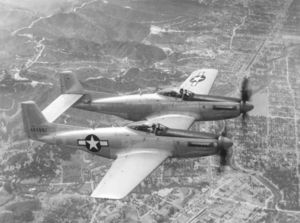
Twin boom
Twin-boom aircraft have their tailplanes and vertical stabilizers mounted on the tail of either two fuselages or on two booms fixed to either both sides of the single fuselage, the wings or the engine nacelles.The reason for this design choice may be:...
design, somewhat similar to the experimental German Messerschmitt Bf 109Z "Zwilling". Although based on the lightweight experimental XP-51F, which would later become the P-51H Mustang, it was actually an entirely new design. North American Design Chief Edgar Schmued
Edgar Schmued
Edgar Schmued , German-American aircraft designer was famed for his design of the iconic North American P-51 Mustang and, later, the North American F-86 Sabre while at North American Aviation. He later worked on other aircraft designs as an aviation consultant.-Early life:Edgar Schmued was born in...
incorporated two P-51H Mustang fuselages lengthened by the addition of a 57 in (145 cm) fuselage plug located behind the cockpit where additional fuel tanks and equipment could be installed. These were mounted to a newly designed center wing section containing the same six .50 in (12.7 mm) M2 Browning machine guns as a single-engine Mustang, but with more concentrated fire. The outer wings were strengthened to allow the addition of hard points for carrying additional fuel or 1,000 lb (454 kg) of ordnance. The two vertical tails were also from the XP-51F, but incorporated large dorsal fillets for added stability in case of an engine failure. The aircraft had a standard landing gear with both wheels retracting into bays under each fuselage center section.
The XP-82 was to be powered by two Packard-built Rolls-Royce V-1650 Merlin
Packard V-1650
The Packard V-1650 was a liquid cooled 27 litre 60° V12 piston aircraft engine variant of the Rolls-Royce Merlin produced under licence by the Packard Motor Car Company...
engines. Initially, the left engine was a V-1650-23 with a gear reduction box to allow the left propeller to turn opposite to the right propeller, which was driven by the more conventional V-1650-25. In this arrangement both propellers would turn upward as they approached the center wing, which in theory would have allowed better single-engine control. This proved not to be the case when the aircraft refused to become airborne during its first flight attempt. After a month of work North American engineers finally discovered that rotating the propellers to meet in the center on their upward turn created sufficient drag to cancel out all lift from the center wing section, one quarter of the aircraft's total wing surface area. The engines and propellers were then exchanged, with their rotation meeting on the downward turn, and the problem was fully solved. The first XP-82 prototype (44-83886) was completed on 25 May 1945, and made the type's first successful flight on 26 June 1945. This aircraft was accepted by the Army Air Forces on 30 August 1945. AAF officials were so impressed by the aircraft while still in development that they ordered the first production P-82Bs in March 1945, fully three months before the aircraft's first flight.
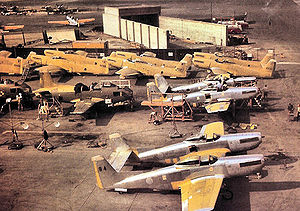
Although some P-82B airframes were completed before the end of World War II
World War II
World War II, or the Second World War , was a global conflict lasting from 1939 to 1945, involving most of the world's nations—including all of the great powers—eventually forming two opposing military alliances: the Allies and the Axis...
, most remained at the North American factory in California waiting for engines until 1946. As a result, none saw service during the war.
Like the P-51 Mustang, the first two prototype XP-82s, as well as the next 20 P-82B models were powered by British-designed Rolls-Royce Merlin
Rolls-Royce Merlin
The Rolls-Royce Merlin is a British liquid-cooled, V-12, piston aero engine, of 27-litre capacity. Rolls-Royce Limited designed and built the engine which was initially known as the PV-12: the PV-12 became known as the Merlin following the company convention of naming its piston aero engines after...
engines, built under license by Packard
Packard
Packard was an American luxury-type automobile marque built by the Packard Motor Car Company of Detroit, Michigan, and later by the Studebaker-Packard Corporation of South Bend, Indiana...
. These provided the fighter with excellent range and performance; however, the Army had always wanted to give the Twin Mustang a purely American and stronger engine than the foreign-designed P-51's V-1650 (built at Packard plants, dismantled after the war). In addition, the licensing costs paid to Rolls-Royce for each V-1650 were being increased by Britain after the war. It therefore negotiated in August 1945 with the Allison Division of the General Motors Corporation for a new version of the Allison V-1710-100 engine. This forced North American to switch subsequent production P-82C and later models to the lower-powered engines. It was found that Allison-powered P-82 models demonstrated a lower top speed and poorer high-altitude performance than the earlier Merlin-powered versions. The earlier P-82B models were designated as trainers, while the "C" and later models were employed as fighters, making the P-82 one of the few aircraft in U.S. military history to be faster in its trainer version than the fighter version.
Record-setting
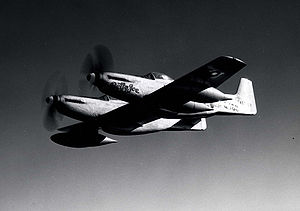
Colonel
Colonel , abbreviated Col or COL, is a military rank of a senior commissioned officer. It or a corresponding rank exists in most armies and in many air forces; the naval equivalent rank is generally "Captain". It is also used in some police forces and other paramilitary rank structures...
Robert E. Thacker
Robert E. Thacker
Colonel Robert E. Thacker, USAF is a retired test pilot, a lifelong model aircraft enthusiast and designer, one of the few pilots in history to do two tours of duty in two different theaters of operation in World War II and the holder of a number of aviation records.Thacker's interest in...
made history when it flew nonstop from Hawaii to New York without refueling, a distance of 5,051 mi (8,129 km) in 14 hr 32 min (347.5 mph/559.2 km/h). This flight tested the P-82's range. The aircraft carried a full internal fuel tank of 576 gal (2,180 l), augmented by four 310 gal (1,173 l) tanks for a total of 1,816 gal (6,874 l). Also, Colonel Thacker forgot to drop three of his external tanks when their fuel was expended, landing with them in New York.
To this day, it remains the longest nonstop flight ever made by a propeller-driven fighter, and the fastest such a distance has ever been covered in a piston-engined aircraft (the record for the longest unrefueled flight by a propeller-driven aircraft of any type is held by the Rutan Voyager). The aircraft chosen was an earlier "B" model powered by Rolls-Royce Merlin engines (see "Survivors" below).
Operational history
The Twin Mustang was developed at the end of the prop-driven fighter era and at the dawn of the jet age. Its designed role as a long-range fighter escort was eliminated by the atomic bombing of Japan and the sudden end of World War II. With the rapid draw-down of the armed forces after the war, the newly established United States Air Force had little money for new prop-driven aircraft, especially since jets, such as the Messerschmitt Me 262Messerschmitt Me 262
The Messerschmitt Me 262 Schwalbe was the world's first operational jet-powered fighter aircraft. Design work started before World War II began, but engine problems prevented the aircraft from attaining operational status with the Luftwaffe until mid-1944...
and other Luftwaffe
Luftwaffe
Luftwaffe is a generic German term for an air force. It is also the official name for two of the four historic German air forces, the Wehrmacht air arm founded in 1935 and disbanded in 1946; and the current Bundeswehr air arm founded in 1956....
fighters had been faster than P-51 Mustangs in the skies of Germany in late 1944. The completed airframes (less engines) of the P-82 pre-production aircraft already manufactured by North American were in storage with an uncertain future.
However, during the 1947 Soviet Aviation Day display at Tushino Airport
Tushino Airport
Tushino airfield is a general aviation airfield located in Tushino, in the northwest part of Moscow, Russia. During the Cold War it was the site of military airshows which reviewed the latest in Soviet innovation...
, a surprise appearance was put in by three four-engined long-range strategic bombers. They were early examples of the Tupolev Tu-4
Tupolev Tu-4
The Tupolev Tu-4 was a piston-engined Soviet strategic bomber that served the Soviet Air Force from the late 1940s to mid 1960s...
, which was a bolt-for-bolt copy of the Boeing B-29 Superfortress, three examples of which had been interned in the Soviet Union
Soviet Union
The Soviet Union , officially the Union of Soviet Socialist Republics , was a constitutionally socialist state that existed in Eurasia between 1922 and 1991....
after having been forced to land there during bombing raids against Japan. Since the USSR was expected soon to have nuclear weapons, the appearance of the Soviet Tu-4 was a shock to US military planners, since it meant that the US mainland might soon be vulnerable to nuclear attack from the air.
Until jet interceptors could be developed and put into service, the Twin Mustangs already built were seen as an interim solution to SAC's fighter escort mission for its strategic bomber force and also as an all-weather air defense interceptor.
Early attempts to develop jet-powered all-weather fighters ran into a series of snags and delays. The XP-87 Blackhawk had been ordered in December 1945, but it ran into developmental difficulties and the project was eventually totally abandoned in October 1948. The Northrop P-89 Scorpion was deemed to have greater promise, but it too ran into teething troubles and did not show promise of entering service until 1952 at the earliest. Due to the lack of any suitable jet-powered replacement, the wartime Northrop P-61 Black Widow night fighter was forced into this role, and in order to help fill in the gap until the Scorpion could be available, night fighter adaptations of the piston-engined North American P-82 Twin Mustang were developed and deployed.
On 11 June 1948, the newly formed United States Air Force eliminated the P-for-pursuit category and replaced it with F-for-fighter. Subsequently, all P-82s were re-designated F-82.
Strategic Air Command
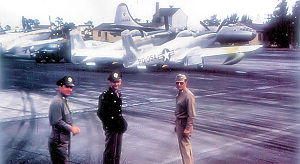
Strategic Air Command
The Strategic Air Command was both a Major Command of the United States Air Force and a "specified command" of the United States Department of Defense. SAC was the operational establishment in charge of America's land-based strategic bomber aircraft and land-based intercontinental ballistic...
27th Fighter (later Fighter-Escort) Wing at Kearney Air Force Base
Kearney Air Force Base
Kearney Air Force Base , was a military airport located four nautical miles northeast of the central business district of Kearney, a city in Buffalo County, Nebraska, United States. After its closure, it was redeveloped into Kearney Regional Airport....
, Nebraska
Nebraska
Nebraska is a state on the Great Plains of the Midwestern United States. The state's capital is Lincoln and its largest city is Omaha, on the Missouri River....
in March 1948.
During World War II, the P-51 Mustang had escorted Boeing B-17 Flying Fortress and Consolidated B-24 Liberator bombers from bases in England and Southern Italy to targets throughout Nazi-occupied Europe. However, the Cold War
Cold War
The Cold War was the continuing state from roughly 1946 to 1991 of political conflict, military tension, proxy wars, and economic competition between the Communist World—primarily the Soviet Union and its satellite states and allies—and the powers of the Western world, primarily the United States...
brought on the challenge of possible B-29, Boeing B-50
Boeing B-50 Superfortress
The Boeing B-50 Superfortress strategic bomber was a post-World War II revision of the Boeing B-29 Superfortress, fitted with more powerful Pratt & Whitney R-4360 radial engines, stronger structure, a taller fin, and other improvements. It was the last piston-engined bomber designed by Boeing for...
or Convair B-36
Convair B-36
The Convair B-36 "Peacemaker" was a strategic bomber built by Convair and operated solely by the United States Air Force from 1949 to 1959. The B-36 was the largest mass-produced piston engine aircraft ever made. It had the longest wingspan of any combat aircraft ever built , although there have...
bomber missions into the Soviet Union
Soviet Union
The Soviet Union , officially the Union of Soviet Socialist Republics , was a constitutionally socialist state that existed in Eurasia between 1922 and 1991....
. The sheer size of the Soviet Union dictated that a bombing mission would be a 12-hour affair there and back from bases in Europe or Alaska, most of it over Soviet territory. Also the weather, which was bad enough in Western Europe, would make bombing missions impossible over the Soviet Union between October and May. With no long-range jet fighters yet available to perform escort missions for the strategic bomber force, the mission of the 27th FEW was to fly these long-range missions with their F-82Es.
The F-82E had a range over 1,400 mi (2,253 km), which meant that with external fuel tanks it could fly from London to Moscow, loiter for 30 minutes over the target, and return, the only American fighter which could do so. It also had an operational ceiling of 40,000 ft (12,192 m), where it could stay close to the bombers it was designed to protect. The first production F-82Es reached the 27th in early 1948, and almost immediately the group was deployed to McChord AFB, Washington, in June where its squadrons stood on alert on a secondary air defense mission due to heightened tensions over the Berlin Airlift. It was also believed that the 27th would launch an escort mission, presumably to the Soviet Union, if conflict broke out in Europe. From McChord, the group flew its Twin Mustangs on weather reconnaissance missions over the northwest Pacific, but problems were encountered with their fuel tanks. Decommissioned F-61 Black Widow external tanks were found at Hamilton AFB, California
California
California is a state located on the West Coast of the United States. It is by far the most populous U.S. state, and the third-largest by land area...
that could be modified for the F-82 which were fitted on the pylons of the Twin Mustang that solved the problem. With a reduction in tensions, the 27th returned to its home base in Nebraska during September where the unit settled down to transition flying with their aircraft.
Four F-82s were deployed to Alaska from McChord where the pilots provided transition training to the 449th Fighter (All Weather) Squadron which used Twin Mustangs in the air defense mission. They remained in Alaska for about 45 days, returning to rejoin the rest of the group at the beginning of November 1948.
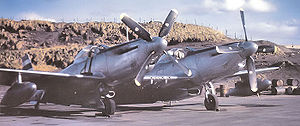
Oklahoma
Oklahoma is a state located in the South Central region of the United States of America. With an estimated 3,751,351 residents as of the 2010 census and a land area of 68,667 square miles , Oklahoma is the 28th most populous and 20th-largest state...
on schedule. The flyover by the Twin Mustangs was a tremendous success, with SAC leadership being amazed that the F-82 was truly an "all weather" aircraft and the 27th being able to carry out their mission despite the weather.
In early 1949, the 27th began carrying out long-range escort profile missions. Flights to Puerto Rico
Puerto Rico
Puerto Rico , officially the Commonwealth of Puerto Rico , is an unincorporated territory of the United States, located in the northeastern Caribbean, east of the Dominican Republic and west of both the United States Virgin Islands and the British Virgin Islands.Puerto Rico comprises an...
, Mexico, the Bahamas and nonstop to Washington D.C were carried out. For President Truman's 1949 inauguration, the 27th FEW launched 48 aircraft to fly in review, along with several other fighter units, in formation down Pennsylvania Avenue. Another flyover over the newly -dedicated Idlewild Airport in New York City soon followed, with the aircraft flying non-stop from Kearney AFB.
In March 1949, Kearney AFB was closed primarily for budgetary reasons and the 27th FEW was reassigned to Bergstrom AFB
Bergstrom Air Force Base
Bergstrom Air Force Base was a United States Air Force base located seven miles southeast of downtown Austin, Texas. It was activated during World War II as a troop carrier training airfield, and was a front-line Strategic Air Command base during the Cold War...
, Texas
Texas
Texas is the second largest U.S. state by both area and population, and the largest state by area in the contiguous United States.The name, based on the Caddo word "Tejas" meaning "friends" or "allies", was applied by the Spanish to the Caddo themselves and to the region of their settlement in...
. Other long-range missions were flown cross-country and simulated "dogfights" with Lockheed F-80 Shooting Star units were carried out. The 27th FEW began transitioning to the Republic F-84 Thunderjet beginning in March 1950, and the F-82Es were largely declared surplus, with the last Twin Mustangs being phased out by September. A few were sent to Far East Air Forces for combat in Korea and a few were sent to Alaska to fly bomber escort missions over the Arctic from Ladd AFB until 1953. The majority were sent to reclamation and were gone by 1952.
With the appearance of the MiG-15
Mikoyan-Gurevich MiG-15
The Mikoyan-Gurevich MiG-15 was a jet fighter developed for the USSR by Artem Mikoyan and Mikhail Gurevich. The MiG-15 was one of the first successful swept-wing jet fighters, and it achieved fame in the skies over Korea, where early in the war, it outclassed all straight-winged enemy fighters in...
over the skies of North Korea
North Korea
The Democratic People’s Republic of Korea , , is a country in East Asia, occupying the northern half of the Korean Peninsula. Its capital and largest city is Pyongyang. The Korean Demilitarized Zone serves as the buffer zone between North Korea and South Korea...
in late 1950, the B-29, as well as all of the propeller-driven bombers in the USAF inventory, were simply rendered obsolete as strategic offensive weapons. The straight-winged F-84Gs used in Korea as bomber escorts were ineffective against the MiG, and it took the swept-wing North American F-86 Sabre to clear the skies. It was clear that it would take a new generation of swept-wing jet bombers, being able to fly higher and faster to effectively defeat the defense of the jet propelled MiG-15 or subsequent Soviet-designed interceptors. Also, the era of large groups of bombers flying in formations to a strategic target ended after the Korean War
Korean War
The Korean War was a conventional war between South Korea, supported by the United Nations, and North Korea, supported by the People's Republic of China , with military material aid from the Soviet Union...
. Strategic bombing evolved into a one-plane, one target affair, with the nuclear-armed Boeing B-52 Stratofortress flying higher and faster than most enemy interceptors. The escort fighter concept became redundant and by 1957, SAC inactivated the last of its strategic fighter escort wings.
Air Defense Command
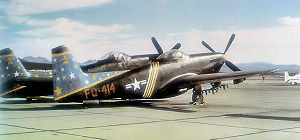
Tupolev Tu-4
The Tupolev Tu-4 was a piston-engined Soviet strategic bomber that served the Soviet Air Force from the late 1940s to mid 1960s...
'Bull' copy of the Boeing B-29 Superfortress in 1947 posed a new threat to postwar USAAF planners, and largely as a result of its appearance and the beginnings of the Cold War
Cold War
The Cold War was the continuing state from roughly 1946 to 1991 of political conflict, military tension, proxy wars, and economic competition between the Communist World—primarily the Soviet Union and its satellite states and allies—and the powers of the Western world, primarily the United States...
in 1948, led to the establishment of Air Defense Command (ADC) as part of the postwar United States Air Force
United States Air Force
The United States Air Force is the aerial warfare service branch of the United States Armed Forces and one of the American uniformed services. Initially part of the United States Army, the USAF was formed as a separate branch of the military on September 18, 1947 under the National Security Act of...
.
In 1947, the embryonic ADC was not particularly effective. During a number of simulated raids on the United States carried out by Strategic Air Command
Strategic Air Command
The Strategic Air Command was both a Major Command of the United States Air Force and a "specified command" of the United States Department of Defense. SAC was the operational establishment in charge of America's land-based strategic bomber aircraft and land-based intercontinental ballistic...
during the period 1947-1949, defending F-51 Mustangs and F-47 Thunderbolts, being used as interceptors, repeatedly failed to find the incoming bombers, even when they knew they were on their way, and seldom got themselves into positions to shoot them down. Furthermore, when they did, the bombers (usually B-29 Superfortresses) had already made their runs over the intended targets of New York City, Los Angeles, Seattle, Chicago and St. Louis.
It was found that the RADAR-equipped wartime Northrop P-61 Black Widow night fighter was effective in locating and attacking the incoming SAC bombers, and also had the range to attack the bombers far from their intended targets. In the late 1940s there were no suitable jet US interceptors yet developed, so the Black Widow was transitioned into the ADC interceptor mission. The F-61s available, however, were largely war-weary and the night fighter F-82C/D models were modified into an all-weather interceptor to replace it.
The production interceptor versions of the Twin Mustang were designated the F-82F and F-82G; the distinguishing feature between the F and G models was largely the nacelle beneath the center-wing that housed radar equipment (F-82F's AN/APG-28 and F-82G's SCR-720C18). In addition, the interceptor version required numerous modifications. The right side cockpit was replaced with a radar operator's position without flight controls. A long radar pod, resembling a sausage and irreverently known as a "long dong," was attached to the underside of the center wing, below the six .50 in (12.7 mm) machine guns and with its dish in front of the propellers to prevent signal interference. This unconventional arrangement was found not to affect the aircraft's performance seriously. Additionally the unit could be jettisoned in an emergency, or for belly landings; it was sometimes lost during high-G maneuvers. F-82F models were designated for ADC units in the United States, while the F-82G models were deployed to Far East Air Forces for air defense of Japan and Okinawa. No F-82s were deployed to Europe.
The first F-82F models began to reach operational ADC squadrons in September 1948. By the end of September, ADC had 29 F-82Fs. By the middle of 1949 the F-82 was replacing Black Widows in service with Air Defense Command along the west coast at Hamilton AFB, California
California
California is a state located on the West Coast of the United States. It is by far the most populous U.S. state, and the third-largest by land area...
(317th FIS) and McChord AFB, Washington (318th FIS, 319th FIS). East coast defense was the mission of the Twin Mustangs assigned to McGuire AFB, New Jersey
New Jersey
New Jersey is a state in the Northeastern and Middle Atlantic regions of the United States. , its population was 8,791,894. It is bordered on the north and east by the state of New York, on the southeast and south by the Atlantic Ocean, on the west by Pennsylvania and on the southwest by Delaware...
(2d FIS, 5th FIS).
In addition to the forces in the Continental United States, the Caribbean Air Command 319th FIS at France Field
Enrique Adolfo Jiménez Airport
Enrique Adolfo Jiménez Airport is a commercial airport located in Colón, Panama, offering scheduled airline flights to the national capital, Panama City, and to other destinations....
in the Panama
Panama
Panama , officially the Republic of Panama , is the southernmost country of Central America. Situated on the isthmus connecting North and South America, it is bordered by Costa Rica to the northwest, Colombia to the southeast, the Caribbean Sea to the north and the Pacific Ocean to the south. The...
Canal Zone
Panama Canal Zone
The Panama Canal Zone was a unorganized U.S. territory located within the Republic of Panama, consisting of the Panama Canal and an area generally extending 5 miles on each side of the centerline, but excluding Panama City and Colón, which otherwise would have been partly within the limits of...
received 15 F-82Fs in December 1948 to replace their Black Widows for the defense of the Panama Canal
Panama Canal
The Panama Canal is a ship canal in Panama that joins the Atlantic Ocean and the Pacific Ocean and is a key conduit for international maritime trade. Built from 1904 to 1914, the canal has seen annual traffic rise from about 1,000 ships early on to 14,702 vessels measuring a total of 309.6...
. The Twin Mustangs remained in Panama only briefly, being reassigned to McChord AFB in May 1949.
The Twin Mustang was phased out of ADC during 1950-1951 by the Lockheed F-94 Starfire, the last being with the 318th FIS at McChord in late 1951. Some were sent to Alaska where they were modified into the F-82H configuration; most, however, were sent to reclamation.
Far East Air Forces
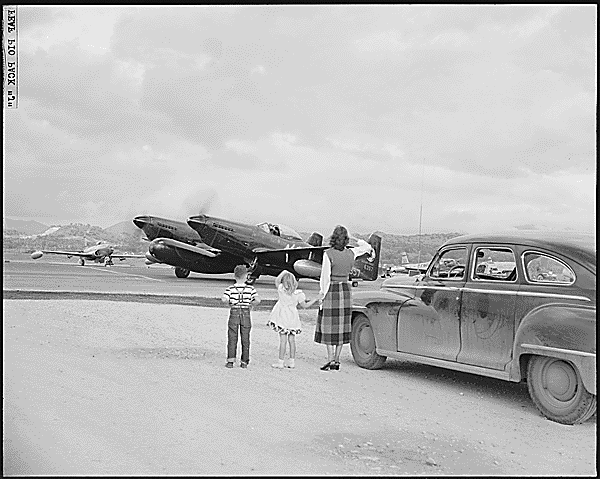
68th Fighter Squadron
The 68th Fighter Squadron was one of the most long-serving Fighter Squadrons in U.S. Air Force history, remaining activated almost continually for 60 years. Known as the "Lightning Lancers", the squadron pioneered radar interception while flying the P-61 Black Widow during World War II...
and 339th Fighter (All Weather) Squadron
339th Flight Test Squadron
The 339th Flight Test Squadron is a United States Air Force unit based at Robins AFB, Georgia. It is part of the Warner Robins Air Logistics Center, with a mission to certify aircraft as worthy to return to service...
s to the reclamation yard at Tachikawa Air Base in February 1950, with Twin Mustangs arriving as replacement aircraft.
In Far East Air Forces, there were three squadrons operating the Twin Mustang consisting of 45 aircraft. The 4th Fighter (All Weather) Squadron
4th Fighter Squadron
The 4th Fighter Squadron is part of the 388th Fighter Wing at Hill Air Force Base, Utah. It operates the F-16 Fighting Falcon aircraft conducting air superiority missions.-History:...
was attached to the 51st Fighter-Interceptor Wing
51st Fighter Wing
The 51st Fighter Wing is a wing of the United States Air Force and the host unit at Osan Air Base, South Korea.The 51st Fighter Wing is under Pacific Air Forces' Seventh Air Force...
at Naha Air Base
Naha Airport
-Incidents:* On December 1, 1994, Ramzi Yousef planted a bomb on Philippine Airlines Flight 434, with the intent of mass murder. The bomb exploded on the Boeing 747-283B en route from Cebu to Tokyo, killing one passenger...
, Okinawa, with the mission of providing air defense within the Twentieth Air Force's area of responsibility during hours of darkness and inclement weather. The 68th F(AW)S area would cover southern Japan from their base at Itazuke
Fukuoka Airport
, formerly known as Itazuke Air Base, is an international and domestic airport located east of Hakata Station in Fukuoka, Japan. It is officially designated a second class airport. It is operating at full capacity, and cannot be further expanded. Flights stop at 10 p.m...
and the 8th Fighter Bomber Wing
8th Fighter Wing
The United States Air Force 8th Fighter Wing is the host unit at Kunsan Air Base, Republic of Korea and is assigned to Seventh Air Force...
, with the 339th F(AW)S covering Tokyo and northern Japan from Johnson Air Base
Iruma Air Base
is a Japan Air Self-Defense Force base located in the city of Sayama, Saitama Prefecture, north of western Tokyo, Japan.Iruma Air Base is currently home to the Air Defense Command Headquarters Flight Group...
. FEAF had about 40 Twin Mustangs assigned to the command.
With the outbreak of the Korean War in June 1950, the F-82 was pressed into operational combat duty. On the night of 24/25 June 1950, 68th Fighter Squadron
68th Fighter Squadron
The 68th Fighter Squadron was one of the most long-serving Fighter Squadrons in U.S. Air Force history, remaining activated almost continually for 60 years. Known as the "Lightning Lancers", the squadron pioneered radar interception while flying the P-61 Black Widow during World War II...
F-82 aircrews standing alert at Itazuke AB were notified at 0400 that FEAF had received a report that North Korea had crossed the 38th Parallel
38th parallel north
The 38th parallel north is a circle of latitude that is 38 degrees north of the Earth's equatorial plane. It crosses Europe, the Mediterranean Sea, Asia, the Pacific Ocean, North America, and the Atlantic Ocean...
and their mission was to fly to the area and report back on any activity seen on the main roads and railroads. When the alert aircraft reached the area it was overcast with cloud tops at about 8,000 ft (2,438 m). Using their airborne search radar, the Twin Mustangs flew through the clouds and broke out at about 2,000 ft (610 m), heading for Kimpo Airfield
Gimpo International Airport
Gimpo International Airport , commonly known as Gimpo Airport , is located in the far western end of Seoul and was the main international airport for Seoul and South Korea before it was replaced by Incheon International Airport in 2001...
near Seoul
Seoul
Seoul , officially the Seoul Special City, is the capital and largest metropolis of South Korea. A megacity with a population of over 10 million, it is the largest city proper in the OECD developed world...
. The pilots observed huge convoys of North Korean trucks and other vehicles, including 58 tanks which had crossed into South Korea. Heading back into the clouds and turning back to Japan, the crews returned to Itazuke AB where they were debriefed by a U.S. Army colonel from General Douglas MacArthur
Douglas MacArthur
General of the Army Douglas MacArthur was an American general and field marshal of the Philippine Army. He was a Chief of Staff of the United States Army during the 1930s and played a prominent role in the Pacific theater during World War II. He received the Medal of Honor for his service in the...
's staff. This reconnaissance flight was later recorded as the first combat mission flown in the Korean War.
With this information, along with other intelligence reports available to them, FEAF confirmed that the Korean People's Army
Korean People's Army
The Korean People's Army , also known as the Inmin Gun, are the military forces of the Democratic People's Republic of Korea. Kim Jong-il is the Supreme Commander of the Korean People's Army and Chairman of the National Defence Commission...
had, indeed, launched a full-scale invasion of South Korea. FEAF's first priority, however, was to evacuate United States citizens. On the morning of 26 June, the nearby Norwegian freighter Reinholte was sent to Inchon harbor to evacuate non-military personnel from Seoul, which lay directly in the invasion route. A flight of Twin Mustangs from the 68th F(AW)S were dispatched to the area, arriving at dawn to provide air protection for the evacuation. Two of the F-82s were dispatched to fly over the road from Seoul, while others flew Top Cover over the Inchon docks. The patrol went without incident until about 1300, when a pair of Soviet-built aircraft (the exact aircraft type has never been determined) came out of the clouds. Orders given to the F-82 pilots prohibited any aggressive action; however, the gun switches were activated when the leader tightened up his turn and peeled off at the F-82s with his wing man in close tail. The F-82s dropped their external tanks, turned on combat power and started a climbing turn towards the North Korean aircraft. For some reason, the North Korean leader fired while too far away with his bullets falling short of the Twin Mustangs. The F-82s pulled up into the clouds and above the overcast, putting them in a position to return fire if the North Koreans followed them. However, they did not, and no further contact was made for the rest of the day. The evacuation at Inchon was successfully carried out with a total of 682 civilians being transported to Sasebo, Japan.
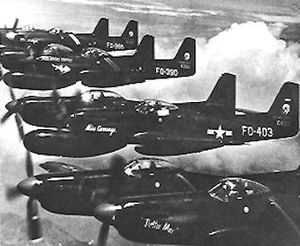
Fifth Air Force
The Fifth Air Force is a numbered air force of the United States Air Force Pacific Air Forces . It is headquartered at Yokota Air Base, Japan....
to move all available aircraft, along with crews and equipment to Itazuke Air Base
Fukuoka Airport
, formerly known as Itazuke Air Base, is an international and domestic airport located east of Hakata Station in Fukuoka, Japan. It is officially designated a second class airport. It is operating at full capacity, and cannot be further expanded. Flights stop at 10 p.m...
to assist the 68th in providing air cover for the evacuation of Seoul
Seoul
Seoul , officially the Seoul Special City, is the capital and largest metropolis of South Korea. A megacity with a population of over 10 million, it is the largest city proper in the OECD developed world...
. However, the 339th's complement of aircraft were scattered over several bases at the time. Seven F-82s were at Yokota AB which were flyable and two were in the hangar undergoing maintenance for major repairs. Four other F-82s were at Misawa AB
Misawa Air Base
right|thumb|A US Navy C-2 at Misawa is a United States military facility located northeast of the railway station in Misawa, west of the Pacific Ocean, northeast of Towada, northwest of Hachinohe, and north of Tokyo, in Aomori Prefecture, in the Tōhoku region in the northern part of the...
on TDY. The three at Yokota were dispatched immediately to Itazuke and well as the four at Misawa making a total of seven combat ready F-82Gs present for duty on 27 June. The 68th F(AW)S had a total of 12 operational F-82Gs. This, combined with what the 339th could contribute was insufficient to meet the combat needs thrust upon FEAF. The F-80 Shooting Star was available, but its thirsty jet engine meant it could only remain over the airfield for a few minutes before having to return to base and could not reach the forward combat area from Japan. No USAF P-51 Mustangs were available, and the British Commonwealth had not yet made a decision to commit to combat Korea, making the Australian
Royal Australian Air Force
The Royal Australian Air Force is the air force branch of the Australian Defence Force. The RAAF was formed in March 1921. It continues the traditions of the Australian Flying Corps , which was formed on 22 October 1912. The RAAF has taken part in many of the 20th century's major conflicts...
Mustangs in Japan academic at this critical situation. FEAF ordered Twentieth Air Force
Twentieth Air Force
The Twentieth Air Force is a numbered air force of the United States Air Force Global Strike Command . It is headquartered at F.E. Warren Air Force Base, Wyoming.20 AF's primary mission is Intercontinental Ballistic Missile operations...
to send eight F-82s from its 4th F(AW)S from Okinawa to Itazuke making a total of 27 F-82s available for combat duty. This was commendable, considering that on 31 May 1950, a total of 32 F-82s existed within FEAF. With these combined squadrons, the 347th Provisional Fighter Group (AW) was formed.
Before dawn on 27 June, the 347th Provisional Group was up in the air over Korea, with a mission to provide cover for the Douglas C-54 Skymaster transports flying in and out of Kimpo Airfield safely as they moved the last civilians out. Fearing that the North Korean Air Force might try to shoot down the transport (a C-54 had been destroyed on the ground at Kimpo by North Korean fighters on 25 June), the Air Force requested air cover to protect the aircraft during takeoff. Fortunately, 339th Fighter All Weather Squadron (F(AW)S) with their F-82Gs were based at Yokota AB and the 68th F(AW)S was based at Itazuke AB
Fukuoka Airport
, formerly known as Itazuke Air Base, is an international and domestic airport located east of Hakata Station in Fukuoka, Japan. It is officially designated a second class airport. It is operating at full capacity, and cannot be further expanded. Flights stop at 10 p.m...
Japan. With Lieutenant Colonel
Lieutenant colonel
Lieutenant colonel is a rank of commissioned officer in the armies and most marine forces and some air forces of the world, typically ranking above a major and below a colonel. The rank of lieutenant colonel is often shortened to simply "colonel" in conversation and in unofficial correspondence...
John F. Sharp in command, 27 F-82Gs of the 35 in Japan answered the call. Arriving in the early morning, they orbited Kimpo Airfield in three flights, each above the other. Suddenly, at 1150 hours, a mixed lot of five North Korean fighters (Soviet-built Yak-9s
Yakovlev Yak-9
The Yakovlev Yak-9 was a single-engine fighter aircraft used by the Soviet Union in World War II and after. Fundamentally a lighter development of the Yak-7 with the same armament, it arrived at the front at the end of 1942. The Yak-9 had a lowered rear fuselage decking and all-around vision canopy...
, Yak-11s and La-7s
Lavochkin La-7
The Lavochkin La-7 was a piston-engined Soviet fighter developed during World War II by the Lavochkin Design Bureau . It was a development and refinement of the Lavochkin La-5, and the last in a family of aircraft that had begun with the LaGG-1 in 1938. Its first flight was in early 1944 and it...
) appeared, heading for the airfield. One of the Yak-11s immediately scored several hits on 68th F(AW)S pilot Lt. Charles Moran's vertical stabilizer. Moments later, Lt. William G. "Skeeter" Hudson, also of the 68th F(AW)S, initiated a high-G turn to engage the Yak. Soon Hudson was closing in on the Yak's tail. He then fired a short burst at close range, scoring hits with his six .50 in (12.7 mm) machine guns. The Yak banked hard to the right, with the F-82G in close pursuit. A second burst hit the Yak's right wing, setting the gas tank on fire and knocking off the right flap and aileron. The North Korean pilot bailed out, but his observer, who was either dead or badly wounded, remained in the doomed aircraft. Parachuting down to Kimpo Airfield, the North Korean pilot was immediately surrounded by South Korean soldiers. Surprisingly, he pulled out a pistol and began firing at them. The South Korean soldiers returned fire, killing the pilot. Moments later, Lt. Moran shot down an La-7 over the airfield, while a few miles away, Major
Major
Major is a rank of commissioned officer, with corresponding ranks existing in almost every military in the world.When used unhyphenated, in conjunction with no other indicator of rank, the term refers to the rank just senior to that of an Army captain and just below the rank of lieutenant colonel. ...
James W. Little, commanding officer of the 339th F(AW)S, shot down another La-7. The C-54 was able to escape safely. Of the five North Korean aircraft dispatched, only two returned to their base. In the process, Lt. William G. "Skeeter" Hudson, with his radar operator Lt. Carl Fraiser, had scored the first aerial "kill" of the Korean War.
Considering these crews had not been extensively trained in air-to-air gunnery, they came out of combat looking very good. It is generally believed that the aircraft Hudson and Fraiser flew that day was an F-82G named "Bucket of Bolts" (s/n 46-383), as their usual aircraft was down for repairs. "Bucket of Bolts" would survive the Korean War and eventually be reassigned to escort duty in Alaska. It is believed to have been scrapped at Ladd AFB, Alaska in 1953.
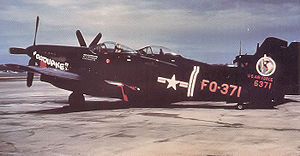
38th parallel north
The 38th parallel north is a circle of latitude that is 38 degrees north of the Earth's equatorial plane. It crosses Europe, the Mediterranean Sea, Asia, the Pacific Ocean, North America, and the Atlantic Ocean...
. Every F-82 which could be made ready for flight was pressed into combat service. Although Fifth Air Force
Fifth Air Force
The Fifth Air Force is a numbered air force of the United States Air Force Pacific Air Forces . It is headquartered at Yokota Air Base, Japan....
needed every available aircraft to slow down the North Korean invasion force, it was hard to justify the release of all F-82s from their defensive responsibilities due to the many key bases in Japan. It was decided to release all F-82s for combat except for a flight which was deployed from the 4th F(AW)S in Okinawa to Japan and a full squadron of F-80s for air defense. On 30 June, FEAF requested HQ USAF
United States Air Force
The United States Air Force is the aerial warfare service branch of the United States Armed Forces and one of the American uniformed services. Initially part of the United States Army, the USAF was formed as a separate branch of the military on September 18, 1947 under the National Security Act of...
for an additional 21 F-82 aircraft, which was denied. In addition, the projected level of support which could be provided at the level of combat usage FEAF was experiencing was no more than 60 days due to a shortage of parts. The fact was that when F-82 production ended in April 1948, no provision had been made for an adequate supply of spare parts, as the aircraft was not expected to remain in operational service once jet-powered aircraft were available. Further, the Air Force simply did not have that many F-82s in the first place (182 total operational aircraft), and did not want to weaken the F-82 units committed to the Pacific Northwest or Atlantic coast, or to draw from the 14 F-82Hs in Alaska.
This was a heavy blow to FEAF planners, as they wanted to use the F-82 for escorting B-26 Invaders deep into North Korea
North Korea
The Democratic People’s Republic of Korea , , is a country in East Asia, occupying the northern half of the Korean Peninsula. Its capital and largest city is Pyongyang. The Korean Demilitarized Zone serves as the buffer zone between North Korea and South Korea...
and for searching out ground targets along the Han River
Han River (Korea)
The Han River is a major river in South Korea and the fourth longest river on the Korean peninsula after the Amnok, Duman, and Nakdong rivers. It is formed by the confluence of the Namhan River , which originates in Mount Daedeok, and the Bukhan River , which originates on the slopes of Mount...
. Making do with what they had was the order of the day, and maintenance crews were cannibalizing everything in sight in order to keep the maximum number of F-82s airborne. During the period 26–30 June, the 68th squadron flew 35 combat sorties, averaging 5 hours per sortie, with the 339th flying similar numbers of missions.
During those early days, the stress and strain of combat put on the crews was intense. However, by early July, the chances of F-82s engaging in air-to-air combat was significantly reduced as the F-80 Shooting Stars had effectively stopped North Korea's air force from coming below the 38th parallel. The F-82s began flying strike and escort missions, along with night intruder sorties. Several F-82s took hits in their radar radomes, which were difficult to replace, and the radomes were removed, turning them into day fighters. In the ground support role, the F-82s could reach any part of the Korean battlefield with a total ordinance load of over 4,000 lb (1,814 kg). Each of the six .50 in (12.7 mm) machine guns carried 400 rounds. This firepower was well-used against numerous ground targets. The escort missions flown with the B-26s took F-82s deep into North Korea. Flying with external fuel tanks, it was necessary on many occasions for the Twin Mustangs to drop tanks due to the risk of fire or explosion if enemy fire hit one of the empty tanks. On 10 July, F-82s from the 4th and 68th squadrons participated in one of the biggest strikes of the war against ground targets. Joined by B-26s and F-80s, the aircraft hit massive amounts of North Korean road traffic. An estimated 117 trucks, 38 tanks and seven personnel carriers were destroyed along with a large number of enemy troops killed when the B-26s destroyed a bridge at Pyongtaek, causing a massive jam.
On 5 July, the 339th Squadron was pulled out of combat and returned to Johnson AB. Shortly afterwords, the 4th Squadron returned to Okinawa, with the 347th Provisional Group being inactivated and control of the 68th Squadron being turned over to the 8th Fighter Group. The 339th had been in combat a total of 10 days (26 June–5 July), flying a total of 44 combat sorties they had been given no training for. The 68th Squadron was left to carry on the battle. Throughout July and August 1950, F-82s from the 68th Squadron attacked enemy trains, vehicles, numerous buildings and constantly strafed North Korean troops on the roads. On the night of 27 August, an element of F-82s was patrolling over South Korea over a thick overcast when they received an urgent request for air support from some hard-pressed ground troops. Darkness was approaching when they reached the area and found UN ground troops pinned down by a concentration of mortars. The F-82 pilots made several passes to get set up with the ground controller, and as soon as the enemy target was pinpointed, the heavily armed aircraft commenced an attack that would last 45 minutes and use up all their ordinance. When the aircraft pulled up for the last time, the mortar positions were silent and ground forces later showed over 300 enemy dead.
Beginning in October 1950, F-82s would start flying weather reconnaissance predawn missions over North Korea. At the same time, the squadron would also be responsible for keeping at least three aircraft on alert on airfields in the Seoul
Seoul
Seoul , officially the Seoul Special City, is the capital and largest metropolis of South Korea. A megacity with a population of over 10 million, it is the largest city proper in the OECD developed world...
area (K-13 (Suwon
Suwon
Suwon is the provincial capital of Gyeonggi-do, South Korea. A major city of over a million inhabitants, Suwon lies approximately south of Seoul. It is traditionally known as "The City of Filial Piety"....
) and K-14 (Kimpo)) during the hours of darkness and bad weather. This would become the main mission for the F-82s for the balance of 1950, as the F-51s, F-80s and F-84s took on most of the combat ground attack missions which the F-82s were pressed into at the beginning of the war. With the entry of the Chinese Communist forces
People's Liberation Army
The People's Liberation Army is the unified military organization of all land, sea, strategic missile and air forces of the People's Republic of China. The PLA was established on August 1, 1927 — celebrated annually as "PLA Day" — as the military arm of the Communist Party of China...
into the war, the situation on the ground began to deteriorate rapidly. By late December, the 68th began flying two-aircraft missions during daylight and single aircraft missions at night from Kimpo AB. On 7 January, FEAF ordered the 68th to start flying armed reconnaissance missions to check roads over southern North Korea
North Korea
The Democratic People’s Republic of Korea , , is a country in East Asia, occupying the northern half of the Korean Peninsula. Its capital and largest city is Pyongyang. The Korean Demilitarized Zone serves as the buffer zone between North Korea and South Korea...
as UN forces were rapidly withdrawing south due to the Chinese onslaught. It was a nightmare as the Chinese were pouring south, and it appeared that the situation was becoming like it was the previous June. On 26 January, the armed reconnaissance missions were discontinued and the F-82s were placed on continuous combat air patrols over Kandong Airfield near Pyongyang
Pyongyang
Pyongyang is the capital of the Democratic People's Republic of Korea, commonly known as North Korea, and the largest city in the country. Pyongyang is located on the Taedong River and, according to preliminary results from the 2008 population census, has a population of 3,255,388. The city was...
and over both of Pyongyang's main airfields, (K-23, Pyongyang and K-24, Pyongyang East) to monitor enemy air activity. This was essential as any Chinese aircraft operating out of these bases would be in easy range of the UN front lines. The 68th's efforts claimed 35 trucks destroyed with damage to many others.
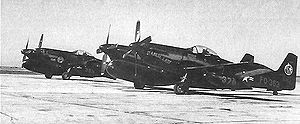
319th Fighter-Interceptor Squadron
The 319th Fighter Interceptor Training Squadron is an inactive United States Air Force unit. Its last assignment was with Aerospace Defense Command's Interceptor Weapons School at Tyndall AFB, Florida...
arrived from Moses Lake AFB Washington and took up residence at K-13. On 28 March 1952, the last F-82G was sent for cold weather modification then deployed to Alaska. By mid-April 1952, the F-82s in Okinawa were also sent to Japan for modification and were also sent to Alaska. All weather responsibilities in FEAF were now in the hands of the F-94 and the jet era.
F-82G operational losses during the Korean War
- 46-357 (6160th ABW, 68th FIS) MIA 28 May 1951, 20 mi (32 km) N of 38th parallel.
- 46-364 (6160th ABW, 68th FIS) destroyed on ground at Suwon, Korea, 29 June 1950 by enemy aircraft.
- 46-373 (6160th ABW, 68th FIS) crashed 5 mi (8 km) NW of Brady AB, Japan, 12 February 1951.
- 46-375 (6160th ABW, 67th FIS) crashed 16 December 1950.
- 46-378 (6160th ABW, 68th FIS) shot down by AAA 3 July 1951.
- 46-391 (51st FIG, 4th FS) in midair collision with F-80C 49-704 between Fukuoka and Ashiya AB, Japan, 29 September 1950.
- 46-394 (6160th ABW, 68th FIS) MIA 14 March 1951.
- 46-399 (6160th ABW, 68th FIS) MIA 27 January 1951.
- 46-400 (6160th ABW, 68th FIS) crashed near K-14 7 December 1950.
- 46-402 (51st FIG, 68th FIS) MIA 6 July 1950.
1951 was the last full year of F-82 operations in Korea, as they were gradually replaced by the jet-powered F-94 Starfire. Twin Mustangs destroyed 20 enemy aircraft, four in the air and 16 on the ground during the conflict.
Alaskan Air Command
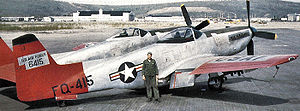
Adak Island
Adak Island is an island near the western extent of the Andreanof Islands group of the Aleutian Islands in Alaska. Alaska's southernmost town, Adak, is located on the island...
in December 1948 to replace their P-61 Black Widows in the Alaska Air Defense mission. The Twin Mustang was well-suited for the air defense mission in Alaska due to their long-range flying ability. In March 1949, the squadron was reassigned to Ladd AFB, near Fairbanks
Fairbanks
Fairbanks may refer to:Places in the United States*Fairbanks, Alaska, city*Fairbanks, California, unincorporated community in El Dorado County*Fairbanks, Mendocino County, California, former settlement*Fairbanks, Indiana, unincorporated community...
where an additional eight (14 total) arrived.
In Alaska, the squadron would constantly patrol over wide areas of Alaska as the Soviets flying from airfields in Siberia
Siberia
Siberia is an extensive region constituting almost all of Northern Asia. Comprising the central and eastern portion of the Russian Federation, it was part of the Soviet Union from its beginning, as its predecessor states, the Tsardom of Russia and the Russian Empire, conquered it during the 16th...
would constantly test the air defenses. Beginning in August 1950, the 449th began receiving the F-94 Starfire jet interceptor, and the F-82s were assigned to a separate detachment within the squadron. With the outbreak of the Korean War, tensions were high in Alaska, as it was feared that it would become a "back door" to Soviet aircraft striking North America. The Soviets were constantly testing the Alaskan air defenses, with the F-94s responding when radar stations alerted them to incoming aircraft. Intercepts were rare, with only a few instances of eye-to-eye contact with Soviet aircraft. The slower F-82s had a longer range than the F-94s, and the Twin Mustangs constantly patrolled over many Alaskan villages and towns. Periodically, the F-82s were used for long-range visual reconnaissance near several known rough airstrips on the Chukchi Peninsula
Chukchi Peninsula
The Chukchi Peninsula, Chukotka Peninsula or Chukotski Peninsula , at about 66° N 172° W, is the northeastern extremity of Asia. Its eastern end is at Cape Dezhnev near the village of Uelen. It is bordered by the Chukchi Sea to the north, the Bering Sea to the south, and the Bering Strait to the...
that the Soviets had used during World War II as landing fields for lend-lease
Lend-Lease
Lend-Lease was the program under which the United States of America supplied the United Kingdom, the Soviet Union, China, Free France, and other Allied nations with materiel between 1941 and 1945. It was signed into law on March 11, 1941, a year and a half after the outbreak of war in Europe in...
aircraft and checking for any activity. In addition, flights around the Nome
Nome
Nome may refer to:A country subdivision:* Nome an administrative division within ancient Egypt.* Nome , the administrative division immediately below the peripheries of Greece Places:* Nome, Norway* Nome, Alaska, US...
area and along the western Alaskan coastline were made. Squadron records show the Twin Mustangs were flown over some of the most remote areas of the Territory along what today is known as the "North Slope" and over very rugged interior regions.
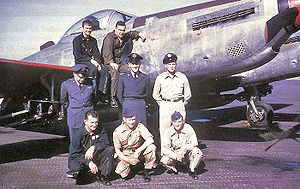
Barter Island
Barter Island is an island located on the Arctic coast of the U.S. state of Alaska, east of Arey Island in the Beaufort Sea. It is about four miles long and about two miles wide at its widest point....
, in the Beaufort Sea
Beaufort Sea
The Beaufort Sea is a marginal sea of the Arctic Ocean, located north of the Northwest Territories, the Yukon, and Alaska, west of Canada's Arctic islands. The sea is named after hydrographer Sir Francis Beaufort...
near the most northern tip of Alaska, about 1,000 mi (1,609 km) south of the North Pole.
Another mission of the 449th was to act as a simulated invasion force during U.S. Army combat maneuvers during the summer months. Army ground units in Alaska were very limited in their movements due to the geography of the land. Most movements were up and down roads and paths and railroad rights-of-way. The F-82s would fly low along the terrain then pop up and initiate simulated strafing runs against them, causing the troops to take cover by hitting the muddy tundra. On occasions, the Twin Mustangs would also drop tear gas canisters, simulating gas attacks on the units.
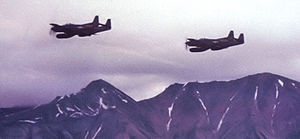
Tanana River
The Tanana River is a tributary of the Yukon River in the U.S. state of Alaska. According to linguist and anthropologist William Bright, the name is from the Koyukon tene no, tenene, literally "trail river"....
, Kuskokwim
Kuskokwim River
The Kuskokwim River or Kusko River is a river, long, in Southwest Alaska in the United States. It is the ninth largest river in the United States by average discharge volume at its mouth and seventeenth largest by basin drainage area.The river provides the principal drainage for an area of the...
and Yukon River
Yukon River
The Yukon River is a major watercourse of northwestern North America. The source of the river is located in British Columbia, Canada. The next portion lies in, and gives its name to Yukon Territory. The lower half of the river lies in the U.S. state of Alaska. The river is long and empties into...
s. This helped avert disastrous floods in the region, dropping 500 lb (227 kg) bombs and firing 5 in (127 mm) rockets at the ice. This allowed the rivers to keep flowing and not get clogged up.
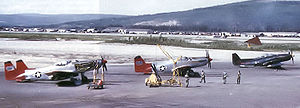
Strategic Air Command
The Strategic Air Command was both a Major Command of the United States Air Force and a "specified command" of the United States Department of Defense. SAC was the operational establishment in charge of America's land-based strategic bomber aircraft and land-based intercontinental ballistic...
began replacing their F-82E bomber escorts and throughout the year, several were transferred to the 449th in Alaska. In February 1951, the Air Force ordered Alaskan Air Command that the all the remaining F-82s in the Air Force inventory would all be transferred to Alaska. The Twin Mustangs would be used to support Army units in air-to-ground operations, and to use the F-94 Starfires for interceptor duty.
During 1951 and 1952, F-82Fs from the Air Defense Command 52d Fighter Group at McGuire AFB and 325th Fighter Group
325th Fighter Wing
The 325th Fighter Wing is a wing of the United States Air Force based out of Tyndall Air Force Base, Florida.-Mission:The 325th Fighter Wing’s primary mission is to provide air dominance training for F-22 Raptor pilots and maintenance personnel and air battle managers to support the combat Air...
at McChord AFB were winterized and flown to Ladd AFB as replacements when those units transitioned to the F-94.
F-82Gs from Far East Air Force were also sent to Alaska as jets took over combat duties over the skies of Korea. The FEAF F-82s, however, arrived in a badly-corroded condition. Also many of these aircraft which were sent to the 449th had high time on their airframes from long bomber escort and air defense flights, as well as the stress from combat duty in Korea had caused many of them to be difficult to maintain. After spending four months at the 39th Air Depot Wing at Elmendorf, most were given-up on and scrapped.
All in all, this provided AAC with a total of 36 various E, F, G and H model F-82s. By 1952, attrition had claimed many of the Twin Mustangs which were assigned to the squadron. The occasional long-range reconnaissance flight over the Bearing Sea was still flown, given the range of the Twin Mustang was much greater than that of the F-94. The right seat of the aircraft was usually occupied by an experienced flight mechanic. With the long patrol flights with high-hour aircraft, pilots began having more and more mechanical problems that forced them to land on crude flight strips. The mechanic usually could repair the aircraft well enough to get airborne and head straight back to Ladd AFB.
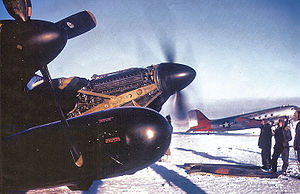
Retirement
The Twin Mustang had a very short operational life. About two years after its introduction to SAC, the F-82E was phased out of service in favor of the jet-powered F-84 Thunderjet for bomber escort duties beginning in 1950. Some were sent to Korea for combat, others were sent to Alaska, but most were declared surplus and were being sent to storage and ultimately reclamation in 1951. Air Defense Command's F-82Fs began to be replaced by F-94 Starfires in 1950, and by early 1951, with most being sent to the smelters, although a few Twin Mustangs remaining in ADC towing aerial targets. In the Pacific, the F-82Gs in combat were also replaced by the F-94 in late 1951 and early 1952, with the survivors being sent to Alaska after being modified to the F-82H configuration in Japan for cold-weather use.Ultimately, due to a lack of spare parts, many of the remaining Twin Mustangs which broke down were cannibalized to keep the other aircraft flying. Eventually all were withdrawn from service when the lack of parts made it impossible to keep the aging airframes flying. The last remaining F-82s were ultimately scrapped at Ladd AFB, Alaska. By June 1953 no F-82s appeared on Air Force, Air National Guard or Air Reserve Forces rolls with some being turned over to museums as static displays.
After the end of their USAF service, the National Advisory Committee for Aeronautics
National Advisory Committee for Aeronautics
The National Advisory Committee for Aeronautics was a U.S. federal agency founded on March 3, 1915 to undertake, promote, and institutionalize aeronautical research. On October 1, 1958 the agency was dissolved, and its assets and personnel transferred to the newly created National Aeronautics and...
(NACA) acquired four surplus F-82s for research work.
- XP-82-NA 44-83886 (c/n 120-43742) (NACA-14). Operated by NACA from 6 June 1948 to 5 October 1955. This aircraft was ultimately sent to salvage at Langley AFB, Virginia.
- XP-82-NA 44-83887 (c/n 120-43743). Operated from October 1947 to July 1950. Used for ram jet tests, it was damaged during July 1950. The damaged aircraft was sold to Walter Soplata and placed on his farm. In March 2008 it was sold to Tom Reilly and moved to his restoration facility in Douglas, GeorgiaDouglas, GeorgiaDouglas is a city in Coffee County, Georgia, United States. As of the 2010 census, the city had a population of 11,589. Douglas is the county seat of Coffee County and the core city of the Douglas, Georgia Micropolitan Statistical Area which has a population of 48,708 as of the 2008 census...
.
- P-82B-NA 44-65168 (c/n 123-43754) (NACA-132). Operated from September 1950 to June 1957: This was the Betty Jo distance record holder aircraft and it was used for ram jet tests. Was turned over to the USAF Museum.
- F-82E-NA 46-256 (c/n 144-38141) (NACA-133). Used for high-altitude icing tests beginning in January 1950, redesignated EF-82E. Sold to Walter Soplata for $1,600 in March 1954. Now being restored to flying condition by C&P Aviation in Anoka, Minnesota.
References for NACA F-82s:
Operators
 United States
United States- Air Defense Command
- 325th Fighter Group (All-Weather)325th Fighter WingThe 325th Fighter Wing is a wing of the United States Air Force based out of Tyndall Air Force Base, Florida.-Mission:The 325th Fighter Wing’s primary mission is to provide air dominance training for F-22 Raptor pilots and maintenance personnel and air battle managers to support the combat Air...
(F-82F 1948 – 1951)
- 325th Fighter Group (All-Weather)
-
- 317th Fighter-All Weather Squadron317th Fighter Interceptor SquadronThe 317th Fighter Interceptor Squadron is an inactive United States Air Force unit, last assigned to Aerospace Defense Command, being stationed at Elmendorf Air Force Base, Alaska. The squadron was inactivated on December 31, 1969.-World War II:...
- Hamilton AFB, CaliforniaCaliforniaCalifornia is a state located on the West Coast of the United States. It is by far the most populous U.S. state, and the third-largest by land area...
, 10 May 1948 - Moses Lake AFB, Washington, 26 November 1948
- McChord AFB, Washington, 23 April 1950 – 1951
- Hamilton AFB, California
- 318th Fighter-All Weather Squadron318th Fighter Interceptor SquadronThe 318th Fighter Interceptor Squadron is an inactive United States Air Force unit. Its last assignment was with 25th Air Division based at McChord AFB, Washington. The squadron was inactivated on December 7, 1989.-World War II:...
- Hamilton AFB, CaliforniaCaliforniaCalifornia is a state located on the West Coast of the United States. It is by far the most populous U.S. state, and the third-largest by land area...
, 10 May 1948 - McChord AFB, Washington, 26 November 1948 – 1951
- Hamilton AFB, California
- 319th Fighter-All Weather Squadron
- France FieldEnrique Adolfo Jiménez AirportEnrique Adolfo Jiménez Airport is a commercial airport located in Colón, Panama, offering scheduled airline flights to the national capital, Panama City, and to other destinations....
, Panama Canal Zone, 14 January 1948 – 29 April 1949- Assigned to: 6th Fighter Wing, Caribbean Air Command
- McChord AFB, Washington, 12 May 1949
- Moses Lake AFB, Washington, 2 September 1949 – 1951
- 52nd Fighter (later Fighter-All Weather) Group52d Fighter WingThe 52d Fighter Wing is a wing of the United States Air Force stationed at Spangdahlem Air Base, Germany.-Mission:The 52 FW maintains, deploys and employs F-16CJ and A/OA-10 aircraft and TPS-75 radar systems in support of NATO and the national defense directives...
(F-82F 1948 – 1950)
- 52nd Fighter (later Fighter-All Weather) Group
- France Field
- 2nd Fighter (later Fighter-All Weather) Squadron2d Fighter SquadronThe 2d Fighter Squadron is an inactive United States Air Force Unit. It was last part of the 325th Fighter Wing at Tyndall Air Force Base, Florida...
- Mitchel AAF, New York, 1948
- McGuire AFB, New JerseyNew JerseyNew Jersey is a state in the Northeastern and Middle Atlantic regions of the United States. , its population was 8,791,894. It is bordered on the north and east by the state of New York, on the southeast and south by the Atlantic Ocean, on the west by Pennsylvania and on the southwest by Delaware...
, 4 October 1949 – 1950
- 5th Fighter (later Fighter-All Weather) Squadron5th Flying Training SquadronThe 5th Flying Training Squadron is part of the 71st Flying Training Wing based at Vance Air Force Base, Oklahoma. It operates T-1 Jayhawk aircraft conducting flight training.-World War II:...
- Mitchel AAF, New York, 1948
- McGuire AFB, New JerseyNew JerseyNew Jersey is a state in the Northeastern and Middle Atlantic regions of the United States. , its population was 8,791,894. It is bordered on the north and east by the state of New York, on the southeast and south by the Atlantic Ocean, on the west by Pennsylvania and on the southwest by Delaware...
, 4 October 1949 – 1950
- 317th Fighter-All Weather Squadron
- Alaska Air CommandEleventh Air ForceThe Eleventh Air Force is a numbered air force of the United States Air Force Pacific Air Forces . It is headquartered at Elmendorf Air Force Base, Alaska....
(F-82H 1948–1953)- 5001st Composite Group
-
- 449th Fighter All-Weather (later Fighter-Interceptor) Squadron449th Fighter Interceptor SquadronThe 449th Fighter Interceptor Squadron is an inactive United States Air Force unit. Its last assignment was with 11th Air Division stationed at Ladd Air Force Base, Alaska. It was inactivated on August 25, 1960.-History:...
(F-82H 1948)- Adak IslandAdak IslandAdak Island is an island near the western extent of the Andreanof Islands group of the Aleutian Islands in Alaska. Alaska's southernmost town, Adak, is located on the island...
, Aleutian Islands, Alaska, 1948 - Ladd AFB, Alaska, 28 March 1949 – 1953
- (Obtained F-82G survivors from Far East Air Force after withdrawal from Korean War combat 1951–1952, also obtained some F-82Fs from Air Defense Command 1950–1952, and F-82Es from SAC 27th FEG in 1950. E/F/G models subsequently modified to F-82H cold weather configuration)
- Adak Island
- 449th Fighter All-Weather (later Fighter-Interceptor) Squadron
- Strategic Air CommandStrategic Air CommandThe Strategic Air Command was both a Major Command of the United States Air Force and a "specified command" of the United States Department of Defense. SAC was the operational establishment in charge of America's land-based strategic bomber aircraft and land-based intercontinental ballistic...
- 27th Fighter-Escort Group (F-82E 1948 – 1950)
-
- Kearney AFB, NebraskaNebraskaNebraska is a state on the Great Plains of the Midwestern United States. The state's capital is Lincoln and its largest city is Omaha, on the Missouri River....
, Neb (1948 – 1950) - Bergstrom AFB, TexasTexasTexas is the second largest U.S. state by both area and population, and the largest state by area in the contiguous United States.The name, based on the Caddo word "Tejas" meaning "friends" or "allies", was applied by the Spanish to the Caddo themselves and to the region of their settlement in...
(1950)- 522d Fighter-Escort Squadron
- 523d Fighter-Escort Squadron
- 524th Fighter-Escort Squadron
- Kearney AFB, Nebraska
- Far East Air Force
- 4th Fighter Squadron4th Fighter SquadronThe 4th Fighter Squadron is part of the 388th Fighter Wing at Hill Air Force Base, Utah. It operates the F-16 Fighting Falcon aircraft conducting air superiority missions.-History:...
(F-82G 1948 – 1952)
- 4th Fighter Squadron
-
- Kadena AB, Okinawa
- 347th Fighter (later Fighter-All Weather) Group347th Rescue GroupThe United States Air Force's 347th Rescue Group is an active combat search and rescue unit assigned to the 23d Wing at Moody AFB, Georgia.-Mission:...
- Attached to: 51st Fighter [later Fighter-Interceptor] Group)51st Fighter WingThe 51st Fighter Wing is a wing of the United States Air Force and the host unit at Osan Air Base, South Korea.The 51st Fighter Wing is under Pacific Air Forces' Seventh Air Force...
, 1948
- Attached to: 51st Fighter [later Fighter-Interceptor] Group)
- Twentieth Air ForceTwentieth Air ForceThe Twentieth Air Force is a numbered air force of the United States Air Force Global Strike Command . It is headquartered at F.E. Warren Air Force Base, Wyoming.20 AF's primary mission is Intercontinental Ballistic Missile operations...
, 24 June 1950- Attached to: 51st Fighter-Interceptor Wing51st Fighter WingThe 51st Fighter Wing is a wing of the United States Air Force and the host unit at Osan Air Base, South Korea.The 51st Fighter Wing is under Pacific Air Forces' Seventh Air Force...
, 24 June 1950- Flight of 8 aircraft attached to 347th Provisional Fighter Group (All Weather), Itazuke AB, Japan, 27 June – 5 July 1950 for combat missions in Korea
- Attached to: 6302d Air Base Group, 20 September 1950
- Attached to: 6351st Air Base Wing, 25 June 1951 – 1952
- Attached to: 51st Fighter-Interceptor Wing
- 68th Fighter Squadron68th Fighter SquadronThe 68th Fighter Squadron was one of the most long-serving Fighter Squadrons in U.S. Air Force history, remaining activated almost continually for 60 years. Known as the "Lightning Lancers", the squadron pioneered radar interception while flying the P-61 Black Widow during World War II...
(F-82G 1949 – 1952)
-
- AshiyaAshiya, Fukuokais a town located in Onga District, Fukuoka, Japan.As of 2003, the town has an estimated population of 16,125 and a density of 1,412.00 persons per km². The total area is 11.42 km²....
AB, Japan, 1949 – 1950 - Itazuke ABFukuoka Airport, formerly known as Itazuke Air Base, is an international and domestic airport located east of Hakata Station in Fukuoka, Japan. It is officially designated a second class airport. It is operating at full capacity, and cannot be further expanded. Flights stop at 10 p.m...
, Japan, 1950 – 1952 - Combat in Korea, 27 June 1950 – 23 March 1952
- 347th Fighter (later Fighter-All Weather) Group347th Rescue GroupThe United States Air Force's 347th Rescue Group is an active combat search and rescue unit assigned to the 23d Wing at Moody AFB, Georgia.-Mission:...
, 1948- Attached to: 8th Fighter-Bomber Wing8th Fighter WingThe United States Air Force 8th Fighter Wing is the host unit at Kunsan Air Base, Republic of Korea and is assigned to Seventh Air Force...
, 1 April 1950
- Attached to: 8th Fighter-Bomber Wing
- Fifth Air ForceFifth Air ForceThe Fifth Air Force is a numbered air force of the United States Air Force Pacific Air Forces . It is headquartered at Yokota Air Base, Japan....
- Attached to: 347th Provisional Fighter Group (All Weather), 27 June – 5 July 1950
- Attached to: 8th Fighter-Bomber Wing8th Fighter WingThe United States Air Force 8th Fighter Wing is the host unit at Kunsan Air Base, Republic of Korea and is assigned to Seventh Air Force...
, 5 July 1950
- 314th Air Division314th Air DivisionThe 314th Air Division is an inactive United States Air Force unit. Its last assignment was with Pacific Air Forces, based at Osan AB, South Korea. It was inactivated in September 1986....
, 1 December 1950- Attached to: 6160th Air Base Wing, 1 December 1950 – 1952
- Ashiya
- 339th Fighter Squadron339th Flight Test SquadronThe 339th Flight Test Squadron is a United States Air Force unit based at Robins AFB, Georgia. It is part of the Warner Robins Air Logistics Center, with a mission to certify aircraft as worthy to return to service...
(F-82G 1949 – 1951)
-
- Johnson AB, Japan, 1949
- Yokota AB, Japan, 1 April 1950
- Johnson AB, Japan, 4 August 1950 – 1951
- 347th Fighter (later Fighter-All Weather) Group347th Rescue GroupThe United States Air Force's 347th Rescue Group is an active combat search and rescue unit assigned to the 23d Wing at Moody AFB, Georgia.-Mission:...
, 1949- Attached to: 35th Fighter [later Fighter-Interceptor] Wing35th Fighter WingThe 35th Fighter Wing is an air combat unit of the United States Air Force and the host unit at Misawa Air Base, Japan. The 35 FW is part of Pacific Air Forces Fifth Air Force.-Mission:...
, 1 Ju1y 1949 – 1 December 1950
- Attached to: 35th Fighter [later Fighter-Interceptor] Wing
- Fifth Air ForceFifth Air ForceThe Fifth Air Force is a numbered air force of the United States Air Force Pacific Air Forces . It is headquartered at Yokota Air Base, Japan....
, 24 June 1950-
- Flight of seven aircraft attached to 347th Provisional Fighter Group (All Weather), Itazuke AB, Japan, 27 June – 5 July 1950 for combat missions in Korea
-
- 314th Air Division314th Air DivisionThe 314th Air Division is an inactive United States Air Force unit. Its last assignment was with Pacific Air Forces, based at Osan AB, South Korea. It was inactivated in September 1986....
, 1 December 1950- Attached to: 6162d Air Base Wing, 1 December 1950 – 25 May 1951
- Air Force Reserve
- 84th Fighter Wing, All Weather84th Combat Sustainment WingThe 84th Combat Sustainment Wing is a wing of the United States Air Force based out of Hill Air Force Base, Utah.-Mission:Provide system support manager functions for air-to-surface munitions, and multiple Command, Control, Communication and Intelligence systems, and supply chain management for...
(F-82F, 1949 – 1951)
-
- McGuire AFB, New JerseyNew JerseyNew Jersey is a state in the Northeastern and Middle Atlantic regions of the United States. , its population was 8,791,894. It is bordered on the north and east by the state of New York, on the southeast and south by the Atlantic Ocean, on the west by Pennsylvania and on the southwest by Delaware...
, 10 October 1949 – 2 June 1951
- McGuire AFB, New Jersey
Source for F-82 operating units
Survivors
Five F-82s are known to still exist.- F-82B Twin Mustang, s/n 44-65162, that been a "gate guard" for many years outside Lackland AFB in Texas, was acquired by the former Confederate Air ForceCommemorative Air ForceThe Commemorative Air Force , formerly known as the Confederate Air Force, is a Texas-based non-profit organization dedicated to preserving and showing historical aircraft at airshows primarily throughout the U.S. and Canada...
in 1966 and was operated for many years by its Midland, TexasMidland, TexasMidland is a city in and the county seat of Midland County, Texas, United States, on the Southern Plains of the state's western area. A small portion of the city extends into Martin County. As of 2010, the population of Midland was 111,147. It is the principal city of the Midland, Texas...
squadron. That F-82B stalled while landing in Harlingen, TexasHarlingen, TexasHarlingen is a city in Cameron County in the heart of the Rio Grande Valley of south Texas, United States, about from the coast of the Gulf of Mexico. The city covers more than , and is the second largest city in Cameron County and the sixth largest in the Rio Grande Valley...
in 1987. The aircraft was restorable but its unique props and landing gear were destroyed in the crash and replacement parts could not be obtained. In 2002, the CAF included it with a crashed P-38 in a trade for a flyable P-38 from a private organization, NPA Holdings. The USAF stepped in and demanded the F-82 be returned since it was only loaned to the CAF on the condition that the CAF return the aircraft to the U.S. Air Force if it was no longer wanted. In a published opinion, the U.S. Sixth Circuit Court of Appeals ruled in December 2009 that the F-82B must be returned to the National Museum of the U.S. Air Force from NPA Holdings because the CAF violated the terms of the loan agreement with the U.S. Air Force. This aircraft arrived at the National Museum of the United States Air Force in late 2009 and underwent an extensive restoration throughout 2010, modifying the aircraft to the appearance of an F-82G. In early 2011, the aircraft was placed on display in the museum's Korean War Gallery, modified and marked as the F-82G crewed by Lts. Charles Moran, pilot, and Fred Larkins, radar observer, 68th F(AW)S, when they shot down a North Korean La-7 on 27 June 1950, near Kimpo Air Base, South Korea. The aircraft is displayed without the F-82G's radar "long dong" pod, as none have been located.
- F-82B Twin Mustang "Betty Jo", s/n 44-65168, is currently on display at The National Museum of the United States Air ForceNational Museum of the United States Air ForceThe National Museum of the United States Air Force is the official museum of the United States Air Force located at Wright-Patterson Air Force Base northeast of Dayton, Ohio. The NMUSAF is the world's largest and oldest military aviation museum with more than 360 aircraft and missiles on display...
, in Dayton, OhioDayton, OhioDayton is the 6th largest city in the U.S. state of Ohio and the county seat of Montgomery County, the fifth most populous county in the state. The population was 141,527 at the 2010 census. The Dayton Metropolitan Statistical Area had a population of 841,502 in the 2010 census...
in its Cold War gallery. The aircraft is displayed in the markings of its historic Hawaii to New York flight in 1947, along with clothing and artifacts used in that record-breaking flight. "Betty Jo" was delivered to the Museum on 21 June 1957. F-82B on display at the Museum of the United States Air Force photo stream
- XP-82 Twin Mustang, s/n 44-83887**. A single fuselage and parts of the second XP-82 were located for many years on the farm of Walter Soplata in Newbury, Ohio. This aircraft was sold in March 2008 to aircraft restorer Tom Reilly. On 7 April 2008, the almost-complete left fuselage with original markings still visible was delivered to Reilly's restoration facility in Douglas, GA along with various surviving components from Soplata's farm. Reilly plans to use the left fuselage to reverse-engineer a matching right airframe, and hopes to eventually restore the aircraft to flying condition. This is by far the most ambitious F-82 restoration project in progress. With the problems encountered by the CAF over a period of 20 years in locating just a set of props and landing gear to return their aircraft to the air, one can see the magnitude of Reilly's task.
- F-82E Twin Mustang, s/n 46-256**, an intact airframe also formerly located at the Walter Soplata farm, has been sold and moved to C&P Aviation in Anoka, MN, where it is currently undergoing restoration to flying status.
- F-82E Twin Mustang, s/n 46-262 has been a "gate guard" for many years outside Lackland AFB in Texas as part of the USAF History and Traditions Museum in San Antonio, TexasSan Antonio, TexasSan Antonio is the seventh-largest city in the United States of America and the second-largest city within the state of Texas, with a population of 1.33 million. Located in the American Southwest and the south–central part of Texas, the city serves as the seat of Bexar County. In 2011,...
- 29.3933885°N 98.6192492°W.
Reference for Twin Mustang Survivors:
** Aircraft currently in restoration status to return to flying condition.
Variants
| Variant | Produced | Conversions |
|---|---|---|
| XP-82 | 2 | |
| XP-82A | 1 | |
| P-82B | 20 | |
| P-82C | 0 | 1 |
| P-82D | 0 | 1 |
| F-82E | 100 | |
| F-82F | 100 | |
| F-82G | 50 | 9 |
| F-82H | 0 | 15 |
| TOTAL | 273 |
NA-123
- Basic Development design. The NA-123 design was presented by North American Aircraft to the USAAF in February 1944. The design for the new aircraft was for a long-range fighter to penetrate deep into enemy territory. Its immediate role would be to escort the B-29 Superfortress bombers used in the Pacific Theater of OperationsPacific Theater of OperationsThe Pacific Theater of Operations was the World War II area of military activity in the Pacific Ocean and the countries bordering it, a geographic scope that reflected the operational and administrative command structures of the American forces during that period...
against Japan. The USAAF endorsed it at once. A letter contract to construct and test four experimental XP-82 aircraft (P-82 designation) gave way in the same month to an order for 500 production models.
XP-82 / XP-82A
- Prototype. The USAAF accepted the first XP-82 in August 1945 and a second one in September. Both were equipped with Packard Merlin V-1650-23 and -25 engines. The third experimental aircraft, designated XP-82A, had two Allison V-1710-119 engines. It was accepted in October 1945. There is no evidence that the XP-82A was ever actually flown, due to problems with the Allison engines. The fourth XP-82A prototype (44-83889) was cancelled.
P-82B
- Planned production version. With the end of World War II, production plans were cut back significantly. Against the 500 P-82Bs initially planned, overall procurement was finalized on 7 December 1945 at 270 P-82s. Included were 20 P-82Bs already on firm order and later allocated to testing as P-82Z. The USAAF accepted all P-82Zs in fiscal year 1947. Two aircraft were accepted in January 1946, four in February 1947, and 13 in March 1947. By December 1949, no P-82Bs (by then redesignated F-82Bs) remained in the Air Force inventory. These P-82Bs were basically similar to the XP-82, but differed in having provisions for underwing racks.
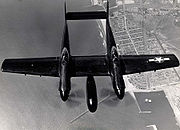
- Night fighter version. A P-82B, (44-65169) modified in late 1946, for testing as a night interceptor. The P-82C featured a new nacelle (under the center wing section) housing an SCR-720 radar. The SCR-720 was the same radar installation which was carried aboard the Northrop P-61 Black Widow, a considerably larger aircraft. The right-hand cockpit became the radar operator's position. The production version was designated P-82F.
P-82D
- Night fighter version. Another P-82B (44-65170) modified with a different radar, the APS-4. The APS-4 was a much smaller set than the SCR-720, and operated in the 3 cm (1.18 in) waveband. As like the P-82C, the right-hand cockpit became the radar operator's position. The production version was designated P-82G.
F-82E
- Escort fighter version. The F-82E followed the F-82B, which it so closely resembled. They were equipped with two counter-rotating Allison liquid-cooled engines, V-1710-143 and V-1710-145. The first four F-82Es were redesignated as F-82As and were allocated for engine testing. After production delays by engine problems and additional testing, F-82Es entered operational service in May 1948. The Air Force accepted 72 F-82Es in fiscal year 1948 (between January and June 1948), and 24 in fiscal year 1949 (22 in July 1948, one in October, and one in December).
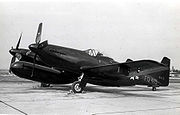
- Night fighter versions. A nacelle beneath the center-wing that housed radar equipment (F-82F's ANIAPG28 and F-82G's SCR-720C18); automatic pilot; and a radar operator replacing the second pilot. When winterization was added to the F or G, it became an F-82H. Entered operational service in September 1948. One F-82G was accepted in fiscal year 1948 (February 1948), all other F-82s (F, G, and H models) in fiscal year 1949. The last F-82G and six winterized F-82Hs were received in March 1949.
Production totals
The Air Force accepted a total of 272 P-82s (including 22 prototype, test and early production aircraft). All examples were redesignated as F-82 in 1948. Specifically, the F-82 program consisted of two XF-82s, one XF-82A, 10 F-82Bs (known for a while as P-82Zs and all allocated to testing), four F-82As, 96 F-82Es, 91 F-82Fs, 45 F-82Gs and 14 F-82Hs. All models and variants of the P-82 were produced at North American's Inglewood, CaliforniaInglewood, California
Inglewood is a city in southwestern Los Angeles County, California, southwest of downtown Los Angeles. It was incorporated on February 14, 1908. Its population stood at 109,673 as of the 2010 Census...
manufacturing plant.
Specifications (F-82G)
See also
External links
- North American F-82 Twin Mustang at the National Museum of the U.S. Air Force
- North American F-82G Twin Mustang at the National Museum of the U.S. Air Force

